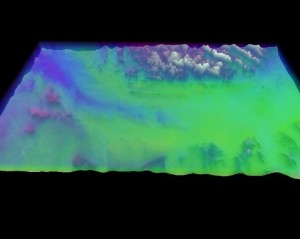Jul 14 2014
It contributes to the rise and fall of dynasties and shapes both the landscape and the cycle of ordinary life. Too much can be ruinous and too little is always devastating. It’s water, the element that Leonardo da Vinci called “the driving force of all nature.”
 Hydrosphere2
Hydrosphere2
In Idaho, water is key to many aspects of life ranging from recreation and agriculture to local drinking supplies. It’s safe to say that having enough is paramount to physical and economic survival. Despite that, scientists haven’t yet come up with an accurate way to predict how much water is in each winter’s snowpack — the primary supply for summer use.
“In the arid West, we don’t have a really good handle on how much water is stored in watersheds, particularly in the mountains as snow,” said geoscientist Alejandro Flores, principal investigator on a new research grant from NASA’s EPSCoR program. EPSCoR is an acronym for the Experimental Program to Stimulate Competitive Research.
Titled “Monitoring Earth’s Hydrosphere: Integrating Remote Sensing, Modeling and Verification,” the grant is for $750,000 over three years. Flores, along with fellow geoscientists Nancy Glenn, Jim McNamara and HP Marshall, will develop more advanced remote-sensing techniques and models to better predict snowmelt and other hydrologic variables.
Current water storage estimates are based largely on manual measurements at a handful of stations that are historically good indicators of snow storage and are safely accessible in the winter.
The current generation of satellites does a poor job of estimating the amount of water in the snowpack. “They can see where the snow is, but not how deep it is or how much water it contains,” Flores said.
Another problem with satellite imaging is that vegetation gets in the way of accurate measurements. In heavily forested watersheds, for instance, satellites will see the treetops but not the snow underneath.
The EPSCoR grant will allow researchers to leverage all existing resources in addition to creating a series of new models to predict and measure how much snow is falling, how much is evaporating and how the rest is moving through the landscape.
Measurement tools include the Weather Research and Forecasting (WRF) model, a numerical weather prediction system that allows researchers to produce simulations that reflect how much precipitation is falling and what it does – whether it is absorbed into the soil, evaporated, etc.
The Boise State researchers will conduct high-level tests to combine new measurements from satellites and models to produce the best possible predictions of water storage and the movement of water in the region.
Co-investigator Glenn says that, “along with several other recent and related grants, this is indicative of Boise State’s growing leadership in remote sensing of natural resources. Our students are receiving state-of-the-art training in a fast-growing technical field, while also receiving mentorship and opportunities to work with NASA scientists and private industry.”
As a way to achieve the “biggest bang for their buck,” Flores said, they’ll also be looking at developing cheaper environmental sensors to measure variables like precipitation, snow depth, temperature and humidity. Cheaper sensors mean they can be placed in more locations, thus increasing the data collected.
This component of the research ties the NASA work to the education component of Flores’ separate National Science Foundation CAREER grant. The NASA EPSCoR grant will extend that educational component by developing modular weather and climate monitoring workshops for K-12 students. In these workshops students use open source electronics and everyday items like bicycle computers to, among other things, log weather data long term.
“The kids will be using the same technologies that we will be using in the research, so we may be able to improve our modeling based on observations collected at the schools,” Flores said.
“This engagement with students also is an opportunity to expose students to the process of scientific research as a potential career path and educate them on the water cycle,” said Glenn.
Researchers are collaborating with NASA’s Jet Propulsion Laboratory, Goddard Space Flight Center and Oakridge National Laboratory, as well as the National Weather Service and Idaho Power.
The grant will be administered through the Idaho Space Grant Consortium.
About Boise State University
A public metropolitan research university with more than 22,000 students, Boise State is proud to be powered by creativity and innovation. Located in Idaho’s capital city, the university has a growing research agenda and plays a crucial role in the region’s knowledge economy and famed quality of life. In the past 10 years, the university has quadrupled the number of doctoral degrees, doubled its masters degrees and now offers 13 online degree programs.Learn more at www.BoiseState.edu.